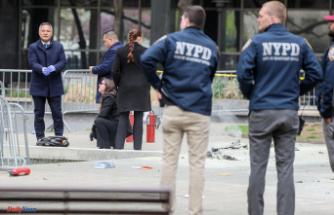In the fearful and provincial Spain that observed the slow decomposition of the Francoism and the ideological transvestism with which many were accepted before the advent of a new stage, the hatching of multiple contraultural expressions in Barcelona, from the Rambleras de Ocaña performances, to music Suburbial of the River Trapera and Journals Ajoblanco and Star, it was a necessary spit punk to the new consensus that wanted to establish the transition. A Underground revolt in which the comic played a special protagonism, with cartoonists as Miguel Ángel Gallardo (Lérida, 1955), died last Monday in Barcelona, as one of his most outstanding references.
Gallardo was next to Juanito Mediavilla, the creator of the Antihero Makoki, his most popular character but not the only one, since Roberto Spain and Manolin emerged from his pencil, Perico Carambola and Dog Nick. He also was part of the founding group in 1979 of the Seminal El Viper Magazine.
As a quinqui neighborhood of Randle McMurphy, the protagonist of someone flew over the cuckoo nest, the novel with which the guru of psychotropic drugs Ken Kesey reported his experiences in a Californian psychiatric, Makoki became an inchultural inch since he started his Wannials in 1977 with revolt in the brake on the pages of the musical magazine Disc Express. From that moment, and until the publication of his last issue, the death of Makoki (1994), Gallardo and Mediavilla converted that alternative quinqui, with a popular and street language and a "Chunga line" drawing - instead remote from The clarity of the classic European comic -, at a countercultural and libertarian symbol, during postfranchise, during the Pujolist regime and, even, in the disillusionment of feliphics.
Makoki is a demented that fled from the asylum to escape the electro-shock. He is always dressed with his shirt and leads a band of Cretinas that mount Broncas in that Barcelona pre-Olympic, dirtiest, less tourist, more violent and less institutional than that of the post Procesors and Ada Colau.
«Inspired by the Aesthetics of Popeye, Elzie Crisler Segar and in the wildest Sperpentry of Valle-Inclán, Gallardo was with Mediavilla the funniest, wild and characteristic antihero creator", says the writer Ignacio Vidal-Folch , who collaborated with him as a scriptwriter of Roberto Spain and Manolin. "He was one of the first he understood that the comic was more than entertainment, which was a means of communication," says the cartoonist Siscu Bellido.
With the character of Makoki, Gallardo gave continuity and synthesized the explosion of the underground comic, which had begun with authors such as Nazario and Marshal. A scene in which Gallardo is mixed at the arrival of him to Barcelona in 1973, initially to study at the University of Fine Arts, although he will end up staring at the Massana School. Son of a Lleida Workers Family, Gallardo was soaked from the most marginal comic, visiting a temple of the counterculture as it was Zap 75, space created by Jaume Fargas and with the reading of comics as Purita (1975), the electric stomach (1976) o The magazine The masked development, which Mariscal, Miquel Farriol and Nazario launched as an iconoclast Letter of presentation of the Underground Spanish.
In those years in which the dream of a different Spain still remained safe from the perversion of power and EGOLATRÍAS, little by little the publications that were fitted to this new generation of Spanish cartoonists, soaked from the American countercultural comic -Bert Curmb, Harvey Pekar ...- And they decided to break into the formal and the aesthetic with the classic TBO and the Brugue School. Gallardo published in Star, Butiparra, Disc Express, Cairo and will be together Max, Josep María Beà, Montesol and other cartoons, one of the founders in 1979 of the Rompedora magazine of El Víbora, whose original name was to be rubber-3 and that He had as a motto "Comix for survivors"
The magazine had the business support of Josep Maria Berenguer and Josep Toutain, and reflected from the purest political and cultural life of the transition, when he still neither heroin nor AIDA had begun to massacrate in an immodestive manner; Generation of Spaniards The viper came to sell up to 50 thousand copies a month and stopped published in 2004, after 300 numbers.
Long before its end, when the Spanish comic industry entered crisis and Makoki blurred, Gallardo drowned in his facet of illustrator and posterist, collaborating with great American cultural magazines, including New Yorker, as well as newspapers like the New York Times and the vanguard. He also wrote graphic novels, among which highlights a long silence and Mary and I, in which he described the close relationship of him with his daughter.
Date Of Update: 22 February 2022, 15:01











